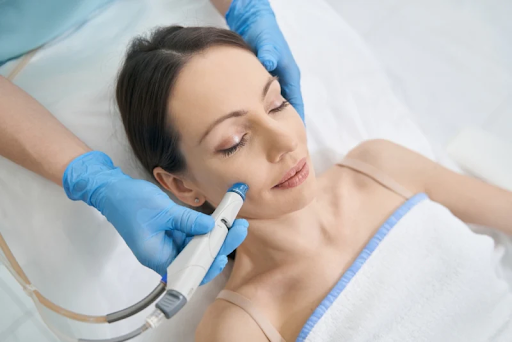Hydrodermabrasion is a modern skincare method that cleans, exfoliates, and hydrates the skin using water and oxygen pressure. It removes dead cells and impurities while adding nourishing serums. This gentle treatment helps improve skin tone, texture, and glow. Many beauty salons use it because it gives fast and visible results without pain or downtime.
Researchers and skincare experts have noted that hydrodermabrasion enhances skin hydration and elasticity. Studies in dermatology journals indicate that it improves blood flow, unclogs pores, and enhances serum absorption. Analysts report that clients see smoother skin and fewer blackheads after a few sessions. Scholars also confirm that it suits different skin types, including sensitive ones, with minimal side effects.
People now look for safe treatments that make skin glow fast. Hydrodermabrasion offers that balance between comfort and results. It keeps the skin healthy and ready for daily skincare products or any skincare tool. Salons use it to attract more clients, while clients choose it to feel confident and fresh. This new trend shows how smart technology is changing everyday beauty care.
Key benefits salons highlight
Improved skin texture. The treatment removes dull surface cells. After the session, the skin feels smoother. Clients see an instant glow. Several clinical studies show visible improvement after a few sessions.
Deep cleansing. The machine extracts clogged pores. This step helps reduce blackheads. It also lowers the chance of breakouts after the session. Salons use this to prepare skin for other treatments.
Hydration and nourishment. The device can push hydrating serums into the skin. These serums contain hyaluronic acid, vitamins, or antioxidants. The skin keeps moisture longer. Hydrated skin looks plump. Many clients book repeat sessions for this effect.
Low downtime. Unlike stronger clinical procedures, hydrodermabrasion needs little recovery. Clients go back to work the same day. This factor makes it popular with busy people.
Versatility. Practitioners adjust pressure, tips, and serums. They tailor the session to oily, dry, or aging skin. This flexibility helps salons serve more clients with one machine.
How salons position the treatment
Salons sell hydrodermabrasion as a complete facial. They present it as cleansing, exfoliation, extraction, and hydration in one. They show before/after photos. They offer packages that combine this treatment with light peels or LED light. These bundles increase the average sale per client.
Technicians also use the machine to boost the effect of topical products. After treatment, the skin absorbs serums more easily. This makes the salon’s own skincare tool choices and skincare products work better for the client.
Evidence and safety
Clinical studies exist for hydradermabrasion devices such as HydraFacial. Research shows good safety and tolerability. Studies report reduced acne and better skin clarity after treatments. These studies come from peer-reviewed journals and clinical trials. They support salon claims for short-term benefits.
Still, not all skin suits this method. People with active rashes, infected skin, or certain skin diseases should skip it. Trained staff must screen clients. They must follow safety steps. Proper cleaning of tips and lines prevents cross-contamination. Clinics and trusted salons follow strict hygiene rules.
Why salons invest in machines
Return on investment. A single machine can serve many clients each week. Salons charge a premium for this service. The device helps attract new clients. Satisfied clients return for follow-ups. Salons earn steady revenue.
Perceived value. Clients see a high-tech device. They feel they get a medical-grade treatment. This perception raises the treatment price. Good marketing and clear results make the service sell well.
Training and control. Many machines let technicians change settings. Technicians learn to treat specific issues. Salons train staff in machine use and aftercare. Proper training reduces risk. It also improves client satisfaction.
How hydrodermabrasion compares to older options
Compared to microdermabrasion, hydrodermabrasion uses water, vacuum, and serums. Microdermabrasion uses abrasive tips or crystals. Hydrodermabrasion tends to feel gentler. It causes less redness for many people. Both can help texture and tone. But hydrodermabrasion adds hydration while it exfoliates. That difference makes salons choose hydrodermabrasion more often now.
Compared to laser or deep peels, hydrodermabrasion offers a lower risk. It also has less downtime. Salons use it as a repeatable, maintenance treatment. For deep scars or strong pigment issues, more intensive medical treatments remain necessary. Clinics often refer those cases to dermatologists.
Best clients for the treatment
People with dull skin. People with mild acne or blackheads. People who want a glowing look before an event. People who want regular skin maintenance. People with sensitive skin often tolerate hydrodermabrasion better than harsher options. Salon staff still test a small area first. This step ensures comfort and safety.
Aftercare salons recommend
Use a gentle cleanser for a few days. Apply a broad-spectrum sunscreen every day. Avoid strong acids or retinoids for 48–72 hours. Keep skin hydrated with mild serums. Follow the salon’s tailored advice. These steps keep the results longer.
Conclusion
Salons use hydrodermabrasion machines because the method fits modern client needs. It pairs clear, visible results with low downtime. The machines let salons serve more clients with one reliable tool. Clinical studies show benefits for common skin issues. Salons that train staff, follow safety rules, and link treatment to real evidence win trust. For clients, a short session can deliver cleaner, hydrated skin that absorbs products better. Machines do not replace medical care. They serve as a safe, effective middle ground between home care and advanced medical procedures.

